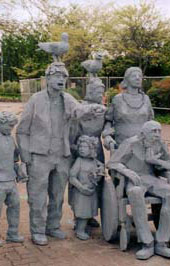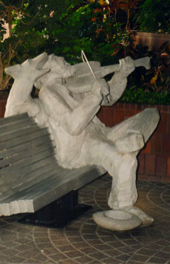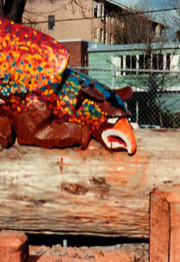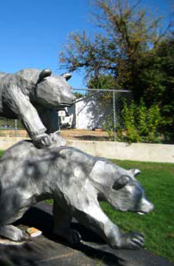Public Sculpture
Richard S. Beyer was an exceptional artist who is little known beyond the Pacific Northwest. His style is unique and expressive with a vision for Public Art has been lost in the official art word of today. You will not find his work in many museums because it is in public places – created for the community, not for his own aggrandizement. He was largely self-taught, having begun adult life working toward an academic career in economics, moving from the East Coast to Seattle, WA in 1957.
By the mid 1960s he realized his best talent was making sculptures out of natural materials. He experimented with different materials and techniques and learned how to convince community organizations to commission his work. He studied the industrial use of Styrofoam to make models for metal casting, and found it faster and more economical than building models in clay, which is the basic technique for creating metal sculpture.
Beyer became an established sculptor in 1978 with the creation of “People Waiting for the Interurban” in Seattle. This was his first try at working in cast aluminum on a large scale, and it became his signature medium throughout his career. During the next 23 years he was very prolific with two to five public commissions nearly every year (two exceptions), - seven in 1994 alone. Seventeen of Beyer’s public sculptures are in Seattle – on sidewalk spaces, at corporations, playgrounds and libraries. In 29 other towns and cities in Washington State you can find his public sculptures. Beyond Washington State, Beyer has sculptures in Oregon, Georgia, California, Virginia, Minnesota, Arkansas, Iowa and the City of Tashkent in Uzbekistan (a Seattle “Sister City”). Rich Beyer’s creative designs are never purely artistic devices. They are physical representations of stories of real life, legends or fanciful tales that relate to the places where they stand.
By the mid 1960s he realized his best talent was making sculptures out of natural materials. He experimented with different materials and techniques and learned how to convince community organizations to commission his work. He studied the industrial use of Styrofoam to make models for metal casting, and found it faster and more economical than building models in clay, which is the basic technique for creating metal sculpture.
Beyer became an established sculptor in 1978 with the creation of “People Waiting for the Interurban” in Seattle. This was his first try at working in cast aluminum on a large scale, and it became his signature medium throughout his career. During the next 23 years he was very prolific with two to five public commissions nearly every year (two exceptions), - seven in 1994 alone. Seventeen of Beyer’s public sculptures are in Seattle – on sidewalk spaces, at corporations, playgrounds and libraries. In 29 other towns and cities in Washington State you can find his public sculptures. Beyond Washington State, Beyer has sculptures in Oregon, Georgia, California, Virginia, Minnesota, Arkansas, Iowa and the City of Tashkent in Uzbekistan (a Seattle “Sister City”). Rich Beyer’s creative designs are never purely artistic devices. They are physical representations of stories of real life, legends or fanciful tales that relate to the places where they stand.




